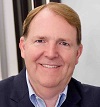 EMAIL
INTERVIEW
– Russ Sharer and Ken Sinclair
EMAIL
INTERVIEW
– Russ Sharer and Ken Sinclair|
May 2018 |
[an error occurred while processing this directive] |
| |
 EMAIL
INTERVIEW
– Russ Sharer and Ken Sinclair
EMAIL
INTERVIEW
– Russ Sharer and Ken Sinclair
Russ Sharer,
Vice President of Global
Marketing and Business
Development
Fulham Co., Inc.
| Articles |
| Interviews |
| Releases |
| New Products |
| Reviews |
| [an error occurred while processing this directive] |
| Editorial |
| Events |
| Sponsors |
| Site Search |
| Newsletters |
| [an error occurred while processing this directive] |
| Archives |
| Past Issues |
| Home |
| Editors |
| eDucation |
| [an error occurred while processing this directive] |
| Training |
| Links |
| Software |
| Subscribe |
| [an error occurred while processing this directive] |
Sinclair: There
is so much talk about IoT – how do you define it for Building
automation and what is standing in its way of wider deployment?
IoT is the interconnection of sensors
and control systems that gather and act upon data to optimize the
operation of a facility for its occupants and owners. It’s been
delayed because in the effort to interconnect “everything” into a
network, the IoT, we have confused the possible with the
probable. I like to say before we can get to IoT, we have to have
IooT – the internet of one thing. Then IoTT – the internet of two
things, and so on. Rather than focusing on connecting everything
and worrying that decisions made today will block applications of the
future, people should just move forward with simple interconnection
focused on cost savings, usually energy or maintenance, and enhancing
the well-being of occupants.
Sinclair: Lighting
is not usually thought of as a key component of building automation
systems. Why do you believe this is a false perception?
The easiest cost savings come from not
spending money on services for empty rooms or finding how to better
utilize or eliminate unused space. In order to do this, data must
be gathered that shows usage patterns. The easiest way to do this
is to use the existing occupancy sensors in most buildings that turn
lights on and off. Without connecting lighting to the larger
building automation, this data is lost, as are potential savings.
Sinclair: In the future, how do you see lighting becoming more critical?
The last 10-15 years have seen a huge
increase in LEEDs approved buildings, but this measurement is focused on
the building and its impact on the environment, not the building’s
impact on its occupants. Now there is a movement towards well
buildings, when many variables – light, temperature, environmental
components – will be considered. Research is proving a link
between the quality and color temperature of a facilities light and its
impact on human performance. This work, classified under Human
Centric Lighting (HCL), shows mimicking sunlight indoors improves
performance, attention and well-being. Think of it as the
lighting equivalent to air conditioning. What impact would not
having air conditioning in the summer or heat in the winter have on
your employee performance?
[an error occurred while processing this directive]Sinclair: Why has it been so difficult to tie building systems such as lighting or air conditioning together?
In nearly every case, the issue is not
technical but structural. The decision makers in buildings and
the supplier of each of these systems are different, and usually never
meet until far up an organization chart. As a result, linking the
systems is an afterthought. If building owners pushed more building
management people to think more broadly, more building systems would be
integrated in a very short period of time.
Sinclair: What is the value of linking a couple of these?
A simple connection of lighting control
and HVAC systems can result in a 25% energy savings on lighting, and 30%
or more on HVAC. Given that those are the 2 largest users of
electricity in a building, the savings can be very large.
What one thing could accelerate Building Automation deployment?
Get everyone in the room associated with building automation and ask how they can work together. Brainstorm. And ask how we save energy and improve the building for occupants.
[an error occurred while processing this directive]
[Click Banner To Learn More]
[Home Page] [The Automator] [About] [Subscribe ] [Contact Us]